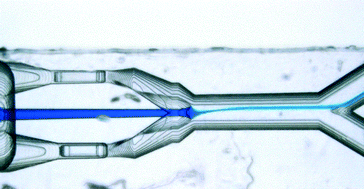A microfluidic opto-caloric switch for sorting of particles by using 3D-hydrodynamic focusing based on SLE fabrication capabilities†
Abstract
In a miniaturised flow switch fluid flows are controlled by reducing the local viscosity via absorption of laser radiation. Through this, the local flow rates are increased to switch the outlet port of a fluid flow carrying the analyte. The microfluidic chip is fabricated using Selective Laser-Induced Etching (SLE). SLE allows novel 3D-hydrodynamic focusing, realising circular shaped channel cross-sections and adapting interaction volume geometries to the profile of the laser radiation for optimised absorption. The performance of the switch is validated experimentally with a dyed analyte and video image processing. The ability to sort particles like cells is demonstrated at 8 Hz using polystyrene beads having a diameter of 8 μm.


 Please wait while we load your content...
Please wait while we load your content...